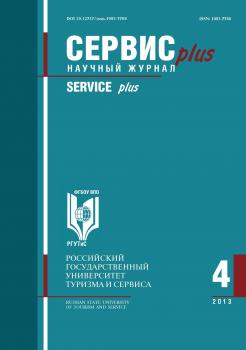Information about educational market functioning is well indicated in educational literature and periodicals. As in any market, there are sellers (those who offer educational services) and consumers (service-users) in educational market. The question about the consumers of educational services is controversial, the understanding of this term is ambiguous. After studying various approaches to the consumers of educational services, we singled out the main groups of secondary vocational education (SVE) customers, then we expanded them and described their correlation with the educational organization and the benefits (i.e. the results of the correlation which satisfied the wants) of each party as applied to small town. The introduced groups underlie the Structure of interaction of educational services consumers (hereinafter the Structure). In the Structure the directions (channels) of formal and informal communications are designated with arrows, the relations with customers are being managed through these channels. This structure of interaction between the SVE educational organization and consumers we define as the scheme of directions (channels) of marketing communications between consumers and the SVE educational organization. Building up the relations with the consumers, the educational organization has a right to choose the way to manage these relations independently. Basing on the Structure, we developed the levels of integration of marketing communications and offered the definitions of marketing communications and integrated marketing communications of the educational organization. Therefore, we concluded that the effective management of relations with consumers consists in the increase of benefits of the consumers and the SVE educational organization itself and can be achieved through the integration of marketing communications taking the means of the organization into account.
integrated marketing communications, educational organization of secondary vocational education, consumers
Вопросы функционирования рынка образовательных услуг довольно широко освещаются как в учебной литературе, так и в периодических изданиях. О.С. Баталова [2] предлагает рынок образовательных услуг определить как социально значимый рынок, на котором осуществляется купля-продажа образовательных услуг и продуктов основными субъектами данного рынка. Как на любом рынке, на рынке образовательных услуг есть продавцы (те, кто предоставляет образовательные услуги) и потребители (пользователи услуг).
Вопрос о потребителях образовательных услуг относится к разряду дискуссионных. К примеру, В.А. Ковалев [6] взял за основу предложение В.Б. Бансловой рассматривать образовательные услуги как способ удовлетворения личных (конечный потребитель), групповых (предприятия-работодатели) и общественных (государство) потребностей. Изучив разные подходы к потребителям образовательных услуг, мы выделили основные группы: студенты, учащиеся, слушатели; родители; работодатели (коммерческие и некоммерче-
ские организации); государства. Приведенная классификация легла в основу разработанной нами структуры взаимодействия потребителей образовательных услуг.
З.И. Иванова [5] утверждает, что в одной из зарубежных работ была доказана зависимость долгосрочной лояльности реальных потребителей и их способности формировать лояльность к организации у потенциальных потребителей от вовлеченности в различные мероприятия, связанные с брендом образовательной организации. Именно поэтому при построении взаимоотношений с потребителями необходимо уделять реальным потребителям внимания не меньше, чем потенциальным и изучать их потребности.
Изучением потребителей образовательных услуг занимаются подразделения и службы, ориентированные на взаимодействие с субъектами рынка образовательных услуг и труда. Это приемные комиссии, службы содействия трудоустройству выпускников, кафедры, отделы маркетинга. В качестве основных инструментов используются проведение интервью
1. Akimova O.E., Popkova E.G., Mitrakhovich T.N. Sovremennye vidy marketingovykh kommunikatsiy v kanalakh raspredeleniya. Ekonomika razvitiya regiona: problemy, poiski, perspektivy: ezhegodnik / VolGU. Volgograd, 2007. Vyp. 8. S. 569-575.
2. Batalova O.S. Spetsifika obrazovatel´noy uslugi kak osnova marketingovoy politiki vuza. Aktual´nye voprosy ekonomiki i upravleniya: materialy mezhdunar. nauch. konf. (g. Moskva, aprel´ 2011 g.).T. II. M.: RI-OR, 2011. S. 7-12.
3. Vliyanie marketingovykh kommunikatsiy na povedenie potrebiteley. URL: http://gendocs.ru/tl/neiorHH/ (data obrashcheniya: 12.03.2014).
4. Golubkova E.N. Marketingovye kommunikatsii. 2-e izd., pererab. i dop. M.: Finpress, 2003.
5. Ivanova Z.I., Kofanov A.V., Elenev K.S. Prodvizhenie brenda gosudarstvennogo vuza: ot postroeniya modeli vospriyatiya brenda do razrabotki kontsepta marketingovykh kommunikatsiy. Marketing i marketingovye issledovaniya. 2011. №1. S. 38-48.
6. Kovalev V.A. Potrebitel´ kak sub´´ekt rynka obrazovatel´nykh uslug: Dis.... kand. ekon. nauk: 08.00.05 : Omsk, 2004. 189 s.
7. Ksenofontova O.L. Metodicheskie aspekty monitoringa rynka obrazovatel´nykh uslug vysshego professional´nogo obrazovaniya. «Sovremennye naukoemkie tekhnologii. Regional´noe prilozhenie» №2(30) 2012URL: e-publ/snt/sites/ru.e-publ.snt/files/ (data obrashcheniya: 05.04.2014).
8. PankrukhinA.P. Marketing: Uchebnik. M.: Omega-L, 2003. 307 s.
9. Popkova E.G. Marketingovye kommunikatsii Sovremennye metody upravleniya [Elektronnyy resurs / KIS Komp´yuternye informatsionnye sistemy]. URL:http://www.cis2000.ru/Budgeting/Mailing/Communikaci. shtml (data obrashcheniya: 08.04.2014).
10. Smit P., Berri K., Pulfor´´ A. Kommunikatsii strategicheskogo marketinga: Uchebnoe posobie / per. s angl. pod red. prof. L.F. Nikulina. M.: YuNITI-DANA, 2001. 415 s.

















